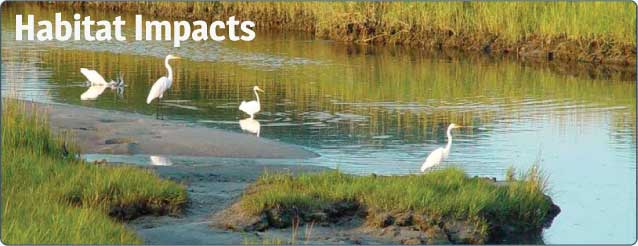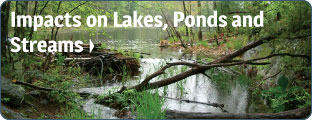
Photo Credit: RI Coastal Resources Management Council
Wild, Wild Life
“Habitats” seems too small a word to describe the wide variety of places where our ecosystem thrives, from bountiful nurseries to a wide variety of fish and animals, to the source of vital services to the environment such as filtering water and protecting people and property from storm surges.
Salt marshes, beaches and dunes, and streams and ponds are at the mercy of climate change. Pushing from one side are the impacts of sea level rise, flooding and more intense storms. Pushing back are the increased pressures of human development, which brings more and more people, and the homes they build, closer to the shore. This squeeze play exacerbates the threats that come with that proximity to what Mother Nature will cook up next in the way of trouble.
Even inland freshwater streams and ponds are impacted. More intense rainstorms and subsequent flooding can cause increased erosion of streambeds and muddying of natural fish habitats. Severe drought conditions can dry up natural fish breeding areas and throw off the life cycles of amphibians (all integrated parts of the fragile circle of life in the wild), while also killing off vegetation that serves as a buffer from the elements and ground zero of a natural water-cleansing process.
And if you want to talk economics, ask any town manager who has had to deal with the destruction of beaches and dunes after an event like Superstorm Sandy, and its ultimate impact on the value of beaches, nearby parking lots and roadways, and businesses that rely upon a vibrant trade among both in-state and out-of-state visitors. Time to think of habitats as a critical piece of community development as opposed to terrain to be held in check.
Impacts on the South Shore Salt Ponds and Salt Marshes (Adobe Acrobat)
Impacts on Beaches and Wetlands (Adobe Acrobat)
“The global warming scenario is pretty grim. I'm not sure I like the idea of polar bears under a palm tree.”
- Lenny Henry
News
“Tourists Are Flocking to Locations Threatened by Climate Change. That Only Makes Things Worse.” Vox
Factoids
Rhode Island’s coastal estuarine environments are experiencing increased water temperatures, alterations in storm and wind patterns, sea level rise and coastal inundation, and marine and coastal acidification.
Inundation of coastal and salt marshes may pose significant risks to Rhode Island’s natural environment. Rising sea level has the potential to degrade brackish wetlands. Salinization will in turn alter wetland vegetative communities and their capacities as nursery and juvenile habitats.
Coastal wetlands may migrate inland with sea level rise and inundation but such landward shifts will be constrained by hardened shorelines and coastal development. Some coastal wetlands will simply shrink and disappear, along with their values as storm buffer zones and habitats.





